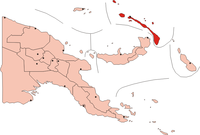
Tatanua mask
Encyclopedia

Papua New Guinea
Papua New Guinea , officially the Independent State of Papua New Guinea, is a country in Oceania, occupying the eastern half of the island of New Guinea and numerous offshore islands...
. The masks are made of wood and other natural materials and used in funeral ceremonies called malagan
Malagan
Malagan ceremonies are large, intricate traditional cultural events that take place in parts of New Ireland province in Papua New Guinea...
.
Manufacture
Tatanua face masks are normally carved from lime woodAlstonia
Alstonia is a widespread genus of evergreen trees and shrubs from the dogbane family . It was named by Robert Brown in 1811, after Charles Alston , Professor of botany at Edinburgh from 1716-1760....
and completed and decorated with fibres from sugar cane, wool and other animal hair. The face is coloured using chalk and other natural dyes. The type with a high headdress are created using a cane framework that was formerly then covered in bark, although later imported fabric was used as the covering. Besides the fabric, some masks also included imported optical brightener
Optical brightener
Optical brighteners, optical brightening agents , fluorescent brightening agents or fluorescent whitening agents are dyes that absorb light in the ultraviolet and violet region of the electromagnetic spectrum, and re-emit light in the blue region...
s, which made some nominally white areas slightly blue.
The masks are frequently identifiable by the pierced ear lobes and prominent mouth, which is normally carved as if the mouth is open. The masks can also be identified by the assymetrical hair design: the mask is left bare of hair on one side to mimic how a New Ireland man would shave his head to show that he was in mourning.
Ceremony
Tatanua masks are worn by ceremonial dancers as part of New Ireland malagan rituals. These are funerary religious ceremonies held by the family of the deceased to communicate with deities and to show respect for the deceased. Mannequins or statues representing the soul of the deceased are also shown at the malagan ceremonies. The local people construct them so that they celebrate the dead person's characteristics. They are elaborated with anthropomorphic symbols which are thought to represent the link between the people of New Ireland, their creation and the spiritual world to which they eventually pass on. The dances were performed in groups; only those who were respected would be allowed the honour of performing the dance, as it was important that observers see the community's strength.The carved masks may take many months to construct, so that the person's death may not be formally marked for some time. The celebrations would be used as a time for the community to illustrate its skills to its neighbours as well as to meet, agree and perform the cultural aspect of a community member dying.
Examples
Examples of this style of mask can be seen in the Ethnological Museum of BerlinEthnological Museum of Berlin
The Ethnological Museum in Berlin is one of the largest ethnological museums in the world. It houses half a million pre-industrial objects, acquired primarily from the German voyages of exploration and colonialization of the late nineteenth and early twentieth centuries...
, Derby Museum and Art Gallery
Derby Museum and Art Gallery
Derby Museum and Art Gallery was established in 1879, along with Derby Central Library, in a new building designed by Richard Knill Freeman and given to Derby by Michael Thomas Bass. The collection includes a whole gallery displaying the paintings of Joseph Wright of Derby; there is also a large...
, the British Museum
British Museum
The British Museum is a museum of human history and culture in London. Its collections, which number more than seven million objects, are amongst the largest and most comprehensive in the world and originate from all continents, illustrating and documenting the story of human culture from its...
and the Indianapolis Museum of Art
Indianapolis Museum of Art
The Indianapolis Museum of Art is an encyclopedic art museum located in Indianapolis, Indiana, United States. The museum, which underwent a $74 million expansion in 2005, is located on a campus on the near northwest area outside downtown Indianapolis, northwest of Crown Hill Cemetery.The...
.
Further reading
- Malanggan: Art, Memory and Sacrifice, Susanne Küchler, Berg Publishers
- Tatanua Masks from New Ireland, RandAfricanArt.com

